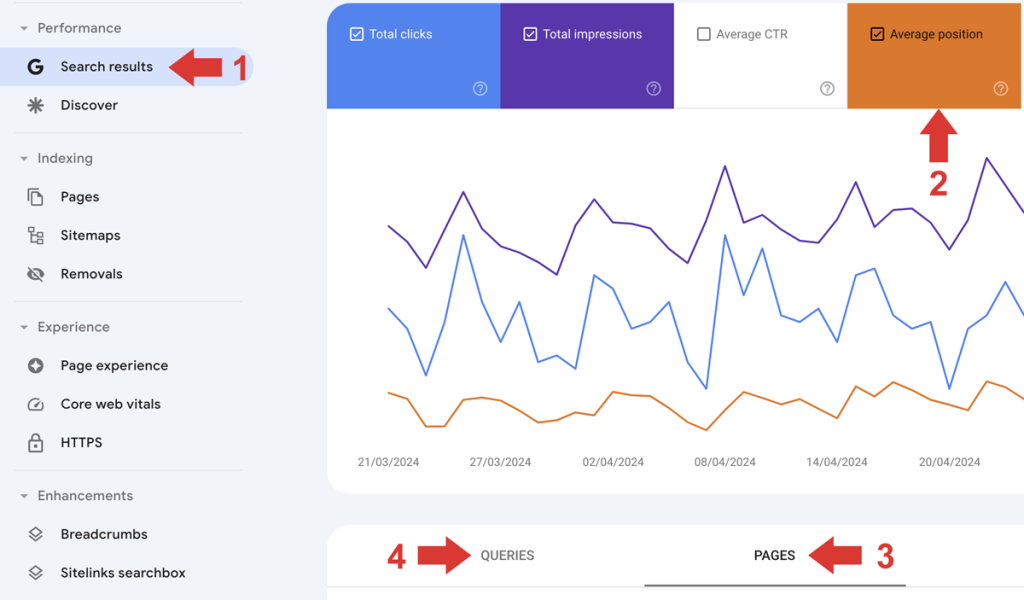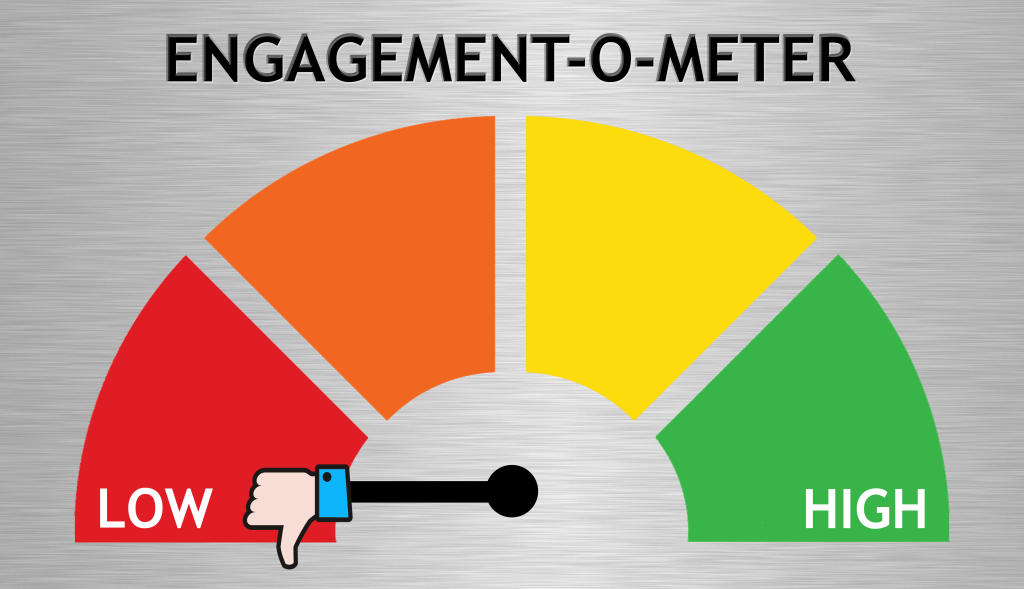Your website isn’t working
Something’s wrong with your website and it’s just not working.
You’re not getting the ideal customers you want and deserve. You’re not making enough sales or getting enough enquiries. You’re answering the same questions over and over again. And you’re not sure what the problem is.
Could it be your copy?
Maybe your words aren’t working for you.
But why not?
Quick links
Scroll down to read the full article, or use one of these quick links to find something specific.
1. Your website isn’t attracting enough visitors
2. Your website is attracting the wrong kinds of visitors
3. Your website isn’t converting enough visitors
4. Your prospects always have the same questions
5. GA4 is showing a low engagement rate
6. Your existing copy is outdated or irrelevant
8. You’ve transformed and rebranded your business
9. Your existing copy doesn’t represent you well
10. Your target audience has changed
10 Surefire signs your web copy might need some attention
1. Your website isn’t attracting enough visitors
If your website isn’t attracting enough visitors, that’s probably because it’s not showing up on Google and your would-be visitors can’t find it.
There’s a bunch of reasons why your website might not be showing up on Google, but one of the most common ones is that your website copy hasn’t been optimised for the right keywords. This is probably the case if you’ve written the copy yourself or you haven’t used an SEO copywriter.
Why do you need an SEO copywriter?
An SEO copywriter understands how web pages are put together to rank well on Google. They’ll research the key words and phrases your target audience is using to find you, then make sure the same words, phrases and language are featured on your web pages.
These phrases are not just your company name, they’re things people would type in if they were looking for a business like yours.
So not just:
❌ Flora’s Florals
But also keywords like:
✅ Fresh flowers
✅ Wedding bouquets
✅ Valentine roses
✅ Funeral flowers.
How are people finding your website?
The easiest way to see how people are finding your site is using your Google Search Console account.
Like Google Analytics (GA4), Search Console is a data collection platform. It’s free to use, but you’ll need a Google account and you’ll need to add it to your website if you haven’t already.
When it’s collected enough data, your screen will look something like this.

To see what your site is being found for:
- Select Search results from the menu on the left
- Make sure the Average position box is checked (it will also turn orange)
- Select Pages from the menu underneath the graph to see a list of all the pages you have listed on Google, then click on your homepage URL
- With your homepage URL selected, click on Queries to see a list of phrases your site is ranking for.
You’ll then see a list showing:
- The keywords your website is being found for
- How many impressions each keyword is generating
- How many click-throughs you’re getting for each keyword
- Your average ranking position for each keyword.
If the keywords in the list aren’t what you want your website to be found for, then your website copy may need some attention.
2. Your website is attracting the wrong kinds of visitors
Your website is attracting visitors, but they’re not your ideal customers, which could mean you’re getting a lot of enquiries from wrong-fit prospects.
If you’re hammering the wrong message, you’ll be screwed when you should be nailing it. Here are a few of the possible reasons why it’s not working.

Your SEO keywords are too broad
Your SEO keywords should be working to bring visitors to your website from Google search. But if your keywords are too broad or too generic, they may not be attracting the right visitors or the people you want to do business with.
Your target audience isn’t obvious
Your website doesn’t make it clear who you work with, what problems you solve for them or who will get the best results from your product or service. Because of this, your ideal customers aren’t identifying themselves in your web copy or seeing you as the right option for them.
Your target audience is wrong
The target customers you’re pitching to aren’t quite the right match for what you’re selling. This might be because your targeting is off or because the nature of what you’re selling has changed since you originally wrote the copy.
Your testimonials are off-target
Your ideal customers will want to see you’ve worked with businesses like theirs and have achieved results for those businesses. But if your testimonials are not from the kinds of businesses you’re targeting, your ideal customers might not be seeing you as the best option for them.
Your CTAs are encouraging wrong-fit prospects
Your CTAs, or calls to action, aren’t working to attract the quality clients you need.
For example, if your main CTA is ‘Book a free call’, this gives the green light for every Tom, Dick and Harry to book calls with you. And you’ll find they’re usually time-wasters, tyre-kickers and price shoppers.
3. Your website isn’t converting enough visitors
Your website is attracting the right kinds of visitors, but they’re not converting into the new business you need. If it’s for one of these reasons, your web copy may need a refresh.

Your hero section isn’t grabbing their attention
Your hero section is the top portion of your homepage, which means it’s the first thing visitors see when your website loads.
In the first few seconds, you need to tell prospects:
- Who you are
- What you do
- Who you do it for
- Why they should care.
If you’re doing that well and creating enough intrigue, your right-fit prospects will feel compelled to scroll down and read more. If you’re not, they won’t.
Your copy is bad
What, like Michael Jackson?
Err… no. Like, it has a lot of issues, such as:
- Poor text/background contrast
- Spelling mistakes and typos
- Over-long sentences
- Grammatical errors
- Dense paragraphs
- Small fonts.
Issues like these make you seem careless and make your copy difficult and unpleasant to read. And that could mean your audience isn’t bothering to read it.
Your audience can’t relate to your copy
If you’re going to convert your prospects into paying customers, you need to make them feel seen and understood. But your copy might not be making the right connection if it’s not addressing their particular pain points, concerns or desires. And if your audience can’t relate, they’re less likely to convert.
Your copy doesn’t speak to your readers
When they read your website, your audience should feel like you’re speaking directly to them. But your web copy is so focused on talking about you, it doesn’t even acknowledge your readers. And it’s all we, us and our when it should be more you and your.
Your offer isn’t specific or clear enough
People won’t buy from you if they don’t understand exactly what they’re getting or how it’s going to help. So you need to be really specific about what you’re offering them and be clear about what it’s going to do for them.
Your value proposition is too vague
Your value proposition should give your visitors clear reasons why they should specifically buy from you. But if the value you’re offering is vague or unspecified, you’re not giving them a reason to buy.
You’re focusing on features, not benefits
Your web copy is all about the features of your product or service. But you need to take that a step further and turn those features into benefits your prospects can understand and relate to. If you’re not doing that, they may not be seeing the value, which is why they’re not converting.
Your language isn’t appropriate
It may not sweary or X-rated, but it’s full of jargon and industry speak, your audience may not be familiar with. If you’re not speaking your customers’ language or they don’t understand what you’re selling, they’re not going to buy from you.
You don’t have any social proof
Prospects will be more likely to buy from you if your other customers have had a good experience. And they learn about your other customers’ experiences by reading their testimonials, reviews and case studies. But if you don’t have this social proof, prospects will be more wary and may decide not to buy.
Your CTAs aren’t clear
Your CTAs, or calls to action, aren’t giving prospects clear direction on what to do next. This is making them feel unsure about taking action when they should be feeling positive and decisive.
4. Your prospects always have the same questions
You find you’re constantly answering the same questions from your prospects. And this is a problem — for them and for you. If you’re experiencing issues like this, improving your web copy could be the answer.

Your copy isn’t answering common questions
Your web copy should be anticipating and answering all the common questions your target customers might have. This will empower them with the knowledge they need for the next part of their customer journey. And it will stop people wasting your time with basic questions your website could have answered.
High-performing websites use a combination of copy and blog content to answer their different audience’s burning questions. The copy on the main website is mainly for prospects who are on the verge of converting.
The content in the blog is for prospects who are still learning about their problem and the possible solutions to it. The idea is that this content will give them the knowledge they need to become customers.
Your copy is unclear or confusing
You think your website has covered everything, but you’re still being asked the most basic questions on the phone and in emails. So what’s the problem?
Maybe your web copy isn’t answering your audience’s questions well enough because they don’t understand it or they find it confusing.
This could be due to:
- Vagueness or ambiguity
- Copy that’s too complex
- Lack of clarity and specificity
- Jargon or unfamiliar terminology
- Awkwardly worded or badly constructed copy.
5. GA4 is showing a low engagement rate
In Google Analytics 4 (GA4), you have what’s called an engagement rate and this is measured by the percentage of engaged sessions your website is getting.

What’s an engaged session?
An engaged session is a website visit that:
- Lasts 10 seconds or longer;
- Has two more page views; OR
- Has one or more conversion events.
Why is my engagement rate low?
If your engagement rate is low, it’s because it isn’t satisfying one of those three requirements and your web copy could be to blame.
Visitors are leaving your website too quickly
Visitors are arriving on your website and leaving in 10 seconds or less. There are a number of reasons why this might be happening.
For example, they:
- Realise they’ve come to the wrong place
- Don’t find your hero section appealing
- Find your website design off-putting
- Don’t understand what you do.
Visitors aren’t going past the first page
Visitors aren’t going any further than the first page they land on. There are a number of possible reasons for this — and they’re not all negative.
For example, they:
- Have found the answers they were looking for
- Get a bad first impression of your website
- Realise your site isn’t what they wanted
- Find your website difficult to navigate.
Visitors aren’t converting
Your visitors aren’t triggering a conversion event, which means they’re not taking any of the actions you have labelled as a conversion.
For example, they’re leaving your website without:
- Signing up to your mailing list
- Registering for your free trial
- Downloading your lead magnet
- Watching your intro video
- Clicking to call you.
6. Your existing copy is outdated or irrelevant
The copy on your website isn’t doing you justice because it’s talking about things that have become dated or are no longer applicable.

For example:
- Software or systems that have been superseded
- Flash-in-the-pan trends that are now a bit sad
- Obsolete equipment people no longer use
- Outdated thinking or approaches.
If your web copy is focusing on things like this, it probably needs a rethink and a revamp.
7. Your tone of voice is off
Your tone of voice is all about the way your copy sounds and the brand personality it conveys. A consistent, recognisable and suitable tone of voice is vital for making the right connection with your audience. But yours isn’t, so it could be time for you to change that.

Your tone isn’t appropriate
Your tone of voice has to represent you and be true to you. But it also has to be appropriate for what you’re selling and your target audience.
Examples of inappropriate tone might include:
- A back street café that sounds like a high-end restaurant
- A serious law firm that sounds too chatty and playful
- A children’s playgroup that sounds too heavy and authoritative
- An over-50s fashion brand that talks in Gen Z slang.
Your tone is bland and uninspiring
A well-crafted tone of voice is interesting and enjoyable to read — and will inspire your audience to read it.
But nobody is going to want to read copy that sounds:
- Wordy and waffly
- Corporate and stuffy
- Droning and monotonous
- Robotic and devoid of personality.
Your tone is inconsistent
Your web copy doesn’t have a cohesive tone, which is not giving your brand a clear identity and is not making the right connection with your audience.
This may have happened because:
There were too many contributors
You thought it was a good idea to delegate some of the copywriting to each department. Because then it would have input from all the right experts in all the right places.
But while your experts might have been the right people to contribute information, that didn’t mean they were good writers or that they would all write in the same way.
You copied and pasted from different websites
You hadn’t really thought about your web copy until your web designer asked you for it. This meant you needed some words quickly and you had no budget left for a copywriter.
So you pulled some copy together by copying and pasting it from other websites. But they all sounded different and none of them sounded like you.
Your copy has evolved over time
Your original web copy was professionally written. But over time multiple amendments and additions have been made by multiple different people. And there’s now a world of difference between the original copy and your current copy.
8. You’ve transformed and rebranded your business
You’ve transformed your business and have rebranded everything. Apart from your copy, which is still the same and doesn’t reflect the changes.

So it could be time to give your old copy the boot and switch it up to match your new image.
9. Your existing copy doesn’t represent you well
Your existing copy doesn’t feel authentic and you don’t feel it represents you or your business as well as it should.

For example, maybe, when you look at your competitors, you think your copy feels:
- Safe and unadventurous
- Bland and lacking personality
- Sterile and sanitised
- All tell and no show.
If your copy is masking the true you, it could be time to change that and reveal your awesomeness to the world.
10. Your target audience has changed
You’ve decided to pivot your business or change your offering and now you’re talking to a different audience than you were before.
For example, maybe your customer base was domestic, but now you’re offering commercial services, too. Or maybe you were selling direct to consumers, but now you want to target distributors instead.
If this is the case for your business, your web copy needs updating to reflect the changes.
Do your website need new web copy?
Maybe you feel seen after reading this article and you know your web copy needs updating. Or maybe you know your website isn’t working and you need someone who can tell you why.
Either way, I may be able to help.
I’m Jenny Lucas and I’m a freelance copywriter based in Leicester, UK.
For the last 15 years, I’ve specialised in writing SEO web copy and blog content for businesses that want to get found on Google, attract their ideal customers and make more money.
If that’s you and you want to fix your web copy so it’s working harder for your business, maybe we should talk.
You can find more about me and the work I do:

You might also like…



